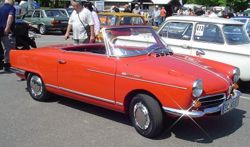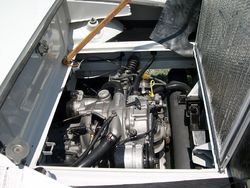- NSU Spider
-
NSU Spider 
Manufacturer NSU Motorenwerke AG Production 1964–1967
2,375 builtAssembly Neckarsulm Successor NSU Ro80 Body style 2-door cabriolet Layout RR layout Engine 498 cc Single rotor Wankel Transmission 4-speed
all-synchromesh manualWheelbase 2,020 mm (80 in) Length 3,580 mm (141 in) Width 1,520 mm (60 in) Height 1,260 mm (50 in) Curb weight 700 kg (1,500 lb)
(Measurements approximate)Designer Claus Luthe The engine bay had originally been designed to take the four-stroke air-cooled two-cylinder engine from the NSU Prinz. The rotary unit was much more compact which permitted a shallow luggage locker to be placed above it. This compensated for reduction in luggage space at the front of the car due to the installation there of the radiator.
The NSU Spider was the first production car in the world to be powered by a Rotary Wankel engine.[1]
Apart from its water-cooled single rotor engine, the car was in most respects unremarkable. However, standard equipment did include disc brakes on the front wheels.
Contents
The Body
First appearing at the Frankfurt Motor Show in 1964, the Spider featured a two-door cabriolet body based on that of the NSU Sport Prinz coupé introduced back in 1959. In addition to the folding roof, the Spider was distinguishable from the hard top car by a grill at the front. As with all NSU cars at the time, the engine was rear-mounted: in order to improve weight distribution, space was found for the Spider’s radiator and for its 35-litre (9 US gal; 8 imp gal) fuel tank ahead of the driver. The front luggage locker was in consequence small.
The Rotary Engine
The Wankel engine, invented by Felix Wankel differed from a piston engine because the quasi-oval design of the combustion chamber, containing a rotor that ascribed within the chamber an Epitrochoid shaped trajectory, enabling the combustion pressure to be converted directly into a rotary motion. There was no need to lose energy converting reciprocating movement into rotational movement. The result was a remarkably compact free revving engine which in the 1960s was hailed by some as the next major step forward in automobile design. It later transpired that the characteristics of certain critical materials selected and applied by NSU to build production rotary engines were inappropriate to the stresses they would bear, and rotary-engined cars acquired a reputation for unreliability. Engines required frequent rebuilding to replace worn apex seals,[2] and warranty costs associated with installation of the engine in NSU’s second Wankel-engined model destroyed the financial viability of NSU, forcing a merger with Audi in 1969.[2] The only large scale automaker to persist with the rotary engine – and then only for niche models – was Mazda: piston engines continued to dominate the world’s automobile engine bays. During the Spider’s production period, these disappointments were generally not foreseen, however.
Claimed output was initially 50 bhp (37 kW) at 5500 rpm, though in later models 54 bhp (40 kW) at 6000 rpm was advertised.
The rotary engine was installed above the rear axle. It was compact, light and very free revving in comparison with conventional engines of the time. By ignoring the manufacturers’ recommendations it was possible to rev the engine briefly above 7000 rpm in the lower gears and thereby to achieve a 0 – 100 km/h (0 – 62 mph) time of 14.5 seconds: other sources, presumably based on following the manufacturers' recommendations, give a time of 15.7 seconds.
Commercial
Large sales volumes were never envisaged for the car, and this was reflected in a relatively high retail price, $2,979 American.[2] Between 1964 and 1967 2,375 were built. In 1967, the model was withdrawn and NSU's second rotary-engined production saloon was presented. The Ro80 would notch up 37,398 units during its ten year production run.
In 1966 Al Auger of Richmond, California USA became the first person in the world to race a Wankel-powered production car in officially sanctioned races. With only installing a mandatory roll-bar and racing tires an NSU Spider raced in 1966 and 1967 in Sports Car Club of America sanctioned road races throughout California finishing second overall champion both years in Class H Modified. Because SCCA had no technical information about the Wankel engine it was placed in H Modified racing against lighter, more powerful 850 cc highly modified pure race cars.
Sources and further reading
- This article incorporates information from the equivalent article on the German Wikipedia.
- This article incorporates information from the revision as of 2008-02-21 of the equivalent article on the Italian Wikipedia.
- ^ "The Wankel Engine History". theautochannel.com. http://www.theautochannel.com/news/2004/07/04/202357.html. Retrieved 2008-02-21.
- ^ a b c "The Rotary Club", Don Sherman, Automobile Magazine, February 2008, pp 76-79
- Eberhard Kittler: DDR Automobil - Klassiker, Band 1. Motorbuch Verlag, Stuttgart 2002, ISBN 3-613-02256-7
- Horst Ihling: Autorennsport in der DDR. Wartburg, EMW & Co. Verlag Delius Klasing, 2006, ISBN 3-7688-5788-3
External links
Categories:- NSU vehicles
- Sports cars
- Rear wheel drive vehicles
- Vehicles with Wankel engines
- 1960s automobiles
- Vehicles introduced in 1964
Wikimedia Foundation. 2010.

